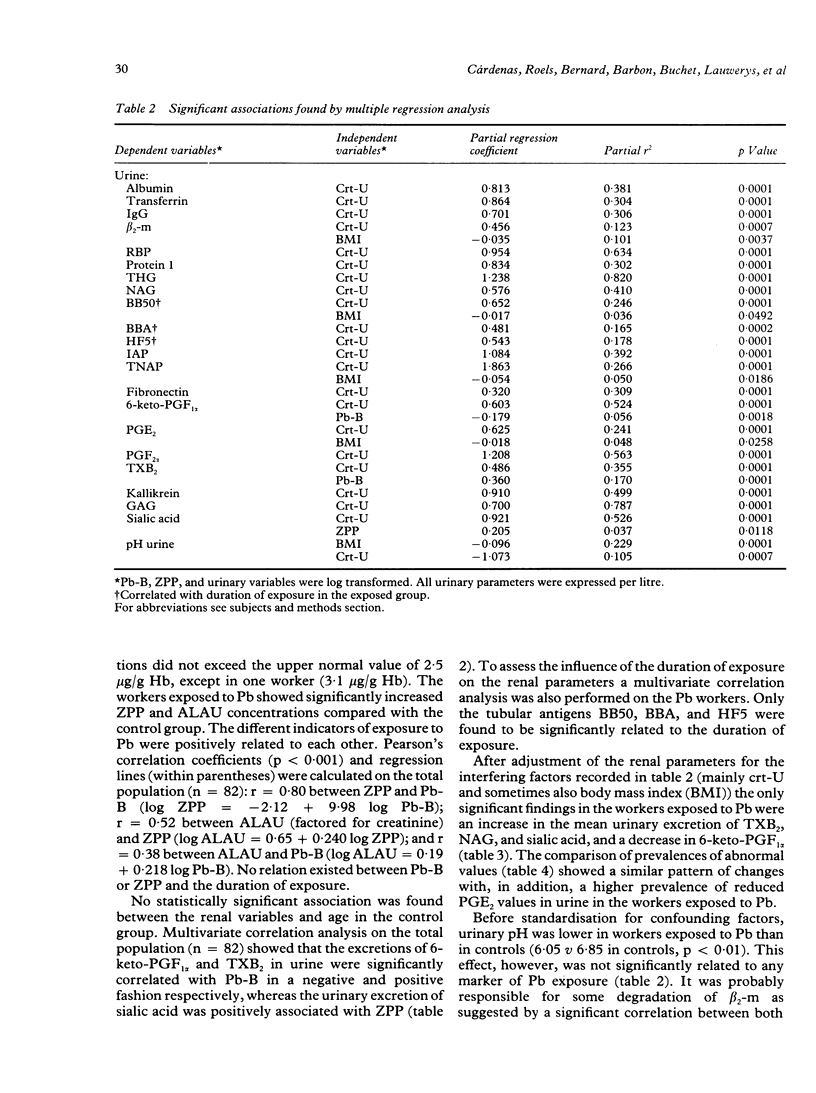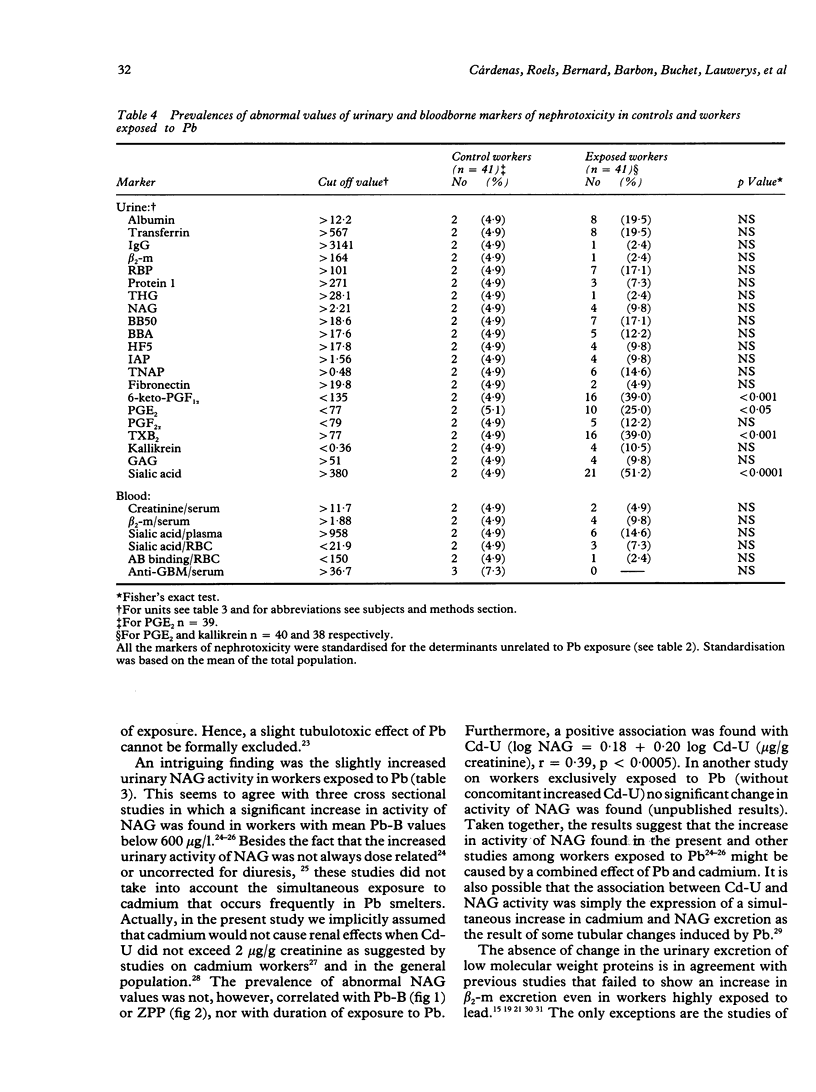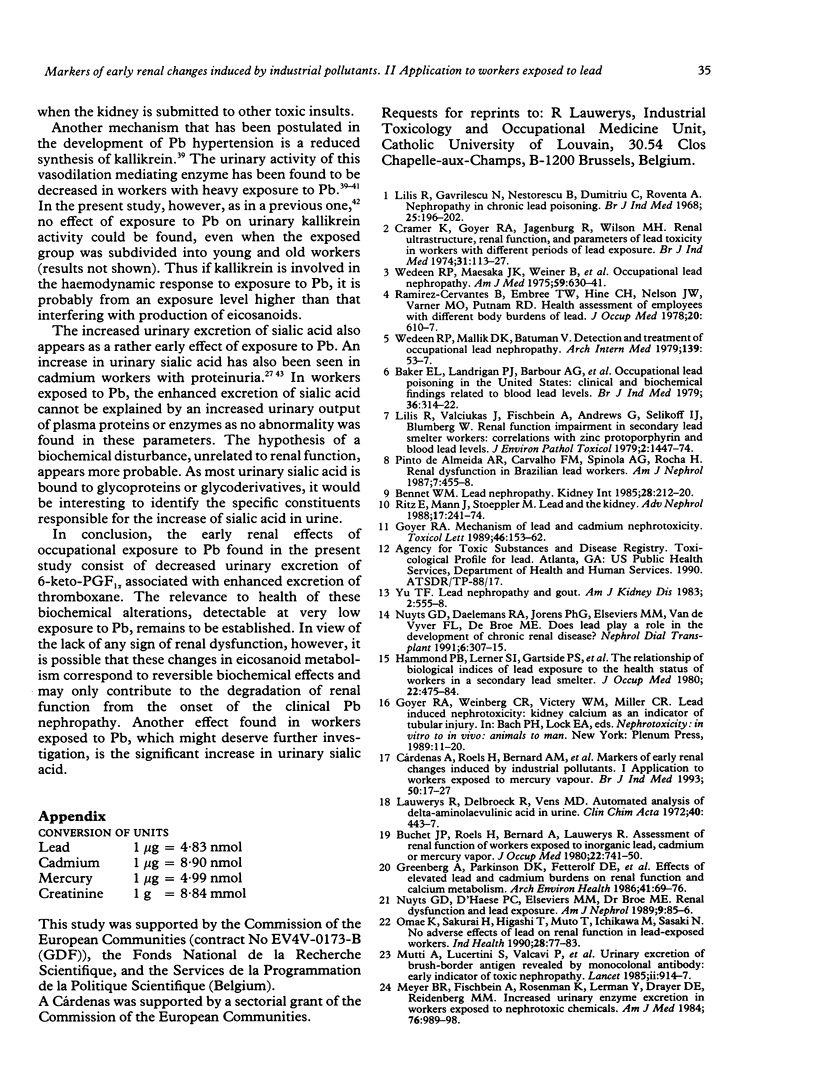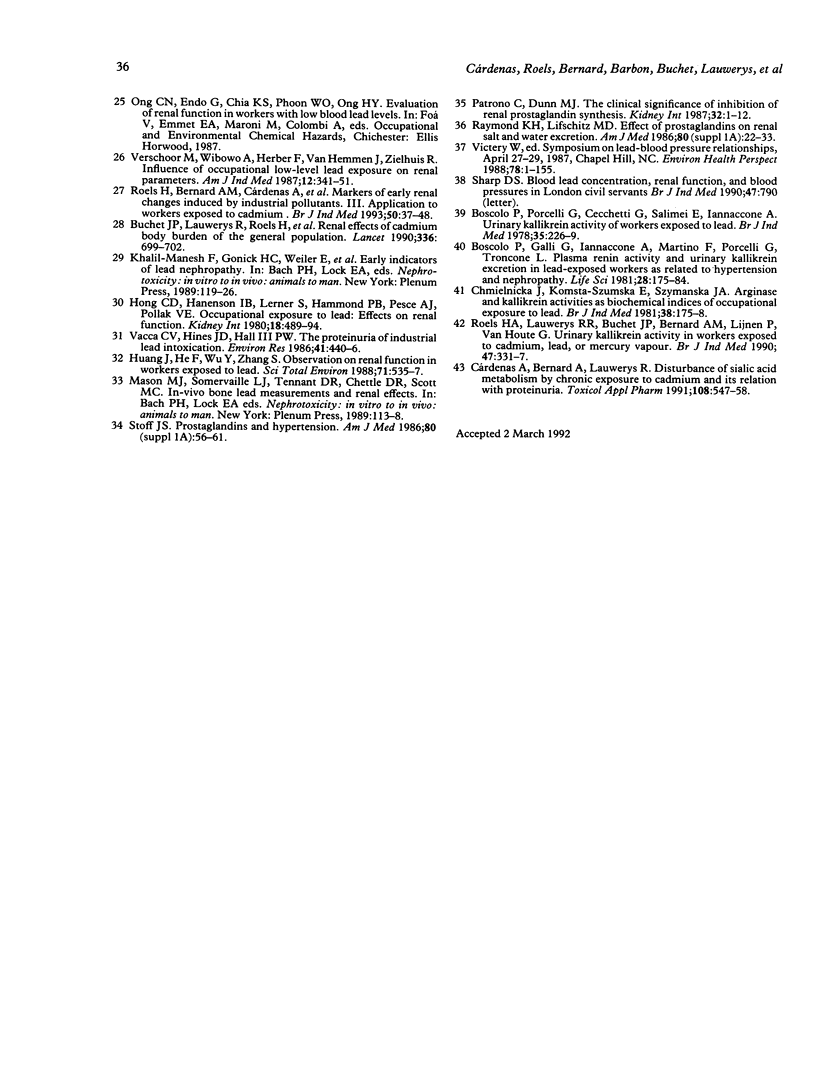Abstract
The present study has been carried out in the framework of a collaborative research project on the development of new markers of nephrotoxicity. A battery of more than 20 potential indicators of renal changes has been applied to 50 workers exposed to lead (Pb) and 50 control subjects. After application of selection criteria 41 exposed and 41 control workers were eventually retained for the final statistical analysis. The average blood Pb concentration of exposed workers was 480 micrograms/l and their mean duration of exposure was 14 years. The battery of tests included parameters capable of detecting functional deficits (for example, urinary proteins of low or high molecular weight), biochemical alterations (for example, urinary eicosanoids, glycosaminoglycans, sialic acid) or cell damage (for example, urinary tubular antigens or enzymes) at different sites of the nephron or the kidney. The most outstanding effect found in workers exposed to Pb was an interference with the renal synthesis of eicosanoids, resulting in lower urinary excretion of 6-keto-PGF1 alpha and an enhanced excretion of thromboxane (TXB2). The health significance of these biochemical alterations, detectable at low exposure to Pb is unknown. As they were not associated with any sign of renal dysfunction, they may represent reversible biochemical effects or only contribute to the degradation of the renal function from the onset of clinical Pb nephropathy. The urinary excretion of some tubular antigens was also positively associated with duration of exposure to Pb. Another effect of Pb that might deserve further study is a significant increase in urinary sialic acid concentration.
Full text
PDF








Selected References
These references are in PubMed. This may not be the complete list of references from this article.
- Baker E. L., Jr, Landrigan P. J., Barbour A. G., Cox D. H., Folland D. S., Ligo R. N., Throckmorton J. Occupational lead poisoning in the United States: clinical and biochemical findings related to blood lead levels. Br J Ind Med. 1979 Nov;36(4):314–322. doi: 10.1136/oem.36.4.314. [DOI] [PMC free article] [PubMed] [Google Scholar]
- Bennett W. M. Lead nephropathy. Kidney Int. 1985 Aug;28(2):212–220. doi: 10.1038/ki.1985.143. [DOI] [PubMed] [Google Scholar]
- Boscolo P., Galli G., Iannaccone A., Martino F., Porcelli G., Troncone L. Plasma renin activity and urinary kallikrein excretion in lead-exposed workers as related to hypertension and nephropathy. Life Sci. 1981 Jan 12;28(2):175–184. doi: 10.1016/0024-3205(81)90550-6. [DOI] [PubMed] [Google Scholar]
- Boscolo P., Porcelli G., Cecchetti G., Salimei E., Iannaccone A. Urinary kallikrein activity of workers exposed to lead. Br J Ind Med. 1978 Aug;35(3):226–229. doi: 10.1136/oem.35.3.226. [DOI] [PMC free article] [PubMed] [Google Scholar]
- Buchet J. P., Lauwerys R., Roels H., Bernard A., Bruaux P., Claeys F., Ducoffre G., de Plaen P., Staessen J., Amery A. Renal effects of cadmium body burden of the general population. Lancet. 1990 Sep 22;336(8717):699–702. doi: 10.1016/0140-6736(90)92201-r. [DOI] [PubMed] [Google Scholar]
- Buchet J. P., Roels H., Bernard A., Lauwerys R. Assessment of renal function of workers exposed to inorganic lead, calcium or mercury vapor. J Occup Med. 1980 Nov;22(11):741–750. [PubMed] [Google Scholar]
- Cardenas A., Bernard A. M., Lauwerys R. R. Disturbance of sialic acid metabolism by chronic cadmium exposure and its relation to proteinuria. Toxicol Appl Pharmacol. 1991 May;108(3):547–558. doi: 10.1016/0041-008x(91)90101-j. [DOI] [PubMed] [Google Scholar]
- Chmielnicka J., Komsta-Szumska E., Szymańska J. A. Arginase and kallikrein activities as biochemical indices of occupational exposure to lead. Br J Ind Med. 1981 May;38(2):175–178. doi: 10.1136/oem.38.2.175. [DOI] [PMC free article] [PubMed] [Google Scholar]
- Cramér K., Goyer R. A., Jagenburg R., Wilson M. H. Renal ultrastructure, renal function, and parameters of lead toxicity in workers with different periods of lead exposure. Br J Ind Med. 1974 Apr;31(2):113–127. doi: 10.1136/oem.31.2.113. [DOI] [PMC free article] [PubMed] [Google Scholar]
- Cárdenas A., Roels H., Bernard A. M., Barbon R., Buchet J. P., Lauwerys R. R., Roselló J., Hotter G., Mutti A., Franchini I. Markers of early renal changes induced by industrial pollutants. I. Application to workers exposed to mercury vapour. Br J Ind Med. 1993 Jan;50(1):17–27. doi: 10.1136/oem.50.1.17. [DOI] [PMC free article] [PubMed] [Google Scholar]
- Goyer R. A. Mechanisms of lead and cadmium nephrotoxicity. Toxicol Lett. 1989 Mar;46(1-3):153–162. doi: 10.1016/0378-4274(89)90124-0. [DOI] [PubMed] [Google Scholar]
- Greenberg A., Parkinson D. K., Fetterolf D. E., Puschett J. B., Ellis K. J., Wielopolski L., Vaswani A. N., Cohn S. H., Landrigan P. J. Effects of elevated lead and cadmium burdens on renal function and calcium metabolism. Arch Environ Health. 1986 Mar-Apr;41(2):69–76. doi: 10.1080/00039896.1986.9937412. [DOI] [PubMed] [Google Scholar]
- Hammond P. B., Lerner S. I., Gartside P. S., Hanenson I. B., Roda S. B., Foulkes E. C., Johnson D. R., Pesce A. J. The relationship of biological indices of lead exposure to the health status of workers in a secondary lead smelter. J Occup Med. 1980 Jul;22(7):475–484. [PubMed] [Google Scholar]
- Hong C. D., Hanenson I. B., Lerner S., Hammond P. B., Pesce A. J., Pollak V. E. Occupational exposure to lead: effects on renal function. Kidney Int. 1980 Oct;18(4):489–494. doi: 10.1038/ki.1980.162. [DOI] [PubMed] [Google Scholar]
- Huang J. X., He F. S., Wu Y. G., Zhang S. C. Observations on renal function in workers exposed to lead. Sci Total Environ. 1988 Jun 1;71(3):535–537. doi: 10.1016/0048-9697(88)90230-6. [DOI] [PubMed] [Google Scholar]
- Lauwerys R., Delbroeck R., Vens M. D. Automated analysis of delta-aminolaevulinic acid in urine. Clin Chim Acta. 1972 Sep;40(2):443–447. doi: 10.1016/0009-8981(72)90356-7. [DOI] [PubMed] [Google Scholar]
- Lilis R., Gavrilescu N., Nestorescu B., Dumitriu C., Roventa A. Nephropathy in chronic lead poisoning. Br J Ind Med. 1968 Jul;25(3):196–202. doi: 10.1136/oem.25.3.196. [DOI] [PMC free article] [PubMed] [Google Scholar]
- Lilis R., Valciukas J., Fischbein A., Andrews G., Selikoff I. J., Blumberg W. Renal function impairment in secondary lead smelter workers: correlations with zinc protoporphyrin and blood lead levels. J Environ Pathol Toxicol. 1979 Jul-Aug;2(6):1447–1474. [PubMed] [Google Scholar]
- Meyer B. R., Fischbein A., Rosenman K., Lerman Y., Drayer D. E., Reidenberg M. M. Increased urinary enzyme excretion in workers exposed to nephrotoxic chemicals. Am J Med. 1984 Jun;76(6):989–998. doi: 10.1016/0002-9343(84)90847-7. [DOI] [PubMed] [Google Scholar]
- Mutti A., Lucertini S., Valcavi P., Neri T. M., Fornari M., Alinovi R., Franchini I. Urinary excretion of brush-border antigen revealed by monoclonal antibody: early indicator of toxic nephropathy. Lancet. 1985 Oct 26;2(8461):914–917. doi: 10.1016/s0140-6736(85)90850-5. [DOI] [PubMed] [Google Scholar]
- Nuyts G. D., D'Haese P. C., Elseviers M. M., De Broe M. E. Renal dysfunction and lead exposure. Am J Nephrol. 1989;9(1):85–86. doi: 10.1159/000167941. [DOI] [PubMed] [Google Scholar]
- Nuyts G. D., Daelemans R. A., Jorens P. G., Elseviers M. M., Van de Vyver F. L., De Broe M. E. Does lead play a role in the development of chronic renal disease? Nephrol Dial Transplant. 1991;6(5):307–315. doi: 10.1093/ndt/6.5.307. [DOI] [PubMed] [Google Scholar]
- Omae K., Sakurai H., Higashi T., Muto T., Ichikawa M., Sasaki N. No adverse effects of lead on renal function in lead-exposed workers. Ind Health. 1990;28(2):77–83. doi: 10.2486/indhealth.28.77. [DOI] [PubMed] [Google Scholar]
- Patrono C., Dunn M. J. The clinical significance of inhibition of renal prostaglandin synthesis. Kidney Int. 1987 Jul;32(1):1–12. doi: 10.1038/ki.1987.164. [DOI] [PubMed] [Google Scholar]
- Pinto de Almeida A. R., Carvalho F. M., Spinola A. G., Rocha H. Renal dysfunction in Brazilian lead workers. Am J Nephrol. 1987;7(6):455–458. doi: 10.1159/000167519. [DOI] [PubMed] [Google Scholar]
- Ramirez-Cervantes B., Embree J. W., Hine C. H., Nelson K. W., Varner M. O., Putnam R. D. Health assessment of employees with different body burdens of lead. J Occup Med. 1978 Sep;20(9):610–617. doi: 10.1097/00043764-197809000-00009. [DOI] [PubMed] [Google Scholar]
- Raymond K. H., Lifschitz M. D. Effect of prostaglandins on renal salt and water excretion. Am J Med. 1986 Jan 17;80(1A):22–33. doi: 10.1016/0002-9343(86)90929-0. [DOI] [PubMed] [Google Scholar]
- Ritz E., Mann J., Stoeppler M. Lead and the kidney. Adv Nephrol Necker Hosp. 1988;17:241–274. [PubMed] [Google Scholar]
- Roels H. A., Lauwerys R. R., Buchet J. P., Bernard A. M., Lijnen P., Van Houte G. Urinary kallikrein activity in workers exposed to cadmium, lead, or mercury vapour. Br J Ind Med. 1990 May;47(5):331–337. doi: 10.1136/oem.47.5.331. [DOI] [PMC free article] [PubMed] [Google Scholar]
- Roels H., Bernard A. M., Cárdenas A., Buchet J. P., Lauwerys R. R., Hotter G., Ramis I., Mutti A., Franchini I., Bundschuh I. Markers of early renal changes induced by industrial pollutants. III. Application to workers exposed to cadmium. Br J Ind Med. 1993 Jan;50(1):37–48. doi: 10.1136/oem.50.1.37. [DOI] [PMC free article] [PubMed] [Google Scholar]
- Sharp D. S. Blood lead concentration, renal function, and blood pressures in London civil servants. Br J Ind Med. 1990 Nov;47(11):790–791. doi: 10.1136/oem.47.11.790-a. [DOI] [PMC free article] [PubMed] [Google Scholar]
- Stoff J. S. Prostaglandins and hypertension. Am J Med. 1986 Jan 17;80(1A):56–61. doi: 10.1016/0002-9343(86)90932-0. [DOI] [PubMed] [Google Scholar]
- Vacca C. V., Hines J. D., Hall P. W., 3rd The proteinuria of industrial lead intoxication. Environ Res. 1986 Dec;41(2):440–446. doi: 10.1016/s0013-9351(86)80138-4. [DOI] [PubMed] [Google Scholar]
- Verschoor M., Wibowo A., Herber R., van Hemmen J., Zielhuis R. Influence of occupational low-level lead exposure on renal parameters. Am J Ind Med. 1987;12(4):341–351. doi: 10.1002/ajim.4700120402. [DOI] [PubMed] [Google Scholar]
- Victery W., Tyroler H. A., Volpe R., Grant L. D. Summary of discussion sessions: symposium on lead-blood pressure relationships. Environ Health Perspect. 1988 Jun;78:139–155. doi: 10.1289/ehp.8878139. [DOI] [PMC free article] [PubMed] [Google Scholar]
- Wedeen R. P., Maesaka J. K., Weiner B., Lipat G. A., Lyons M. M., Vitale L. F., Joselow M. M. Occupational lead nephropathy. Am J Med. 1975 Nov;59(5):630–641. doi: 10.1016/0002-9343(75)90224-7. [DOI] [PubMed] [Google Scholar]
- Wedeen R. P., Malik D. K., Batuman V. Detection and treatment of occupational lead nephropathy. Arch Intern Med. 1979 Jan;139(1):53–57. [PubMed] [Google Scholar]
- Yu T. F. Lead nephropathy and gout. Am J Kidney Dis. 1983 Mar;2(5):555–558. doi: 10.1016/s0272-6386(83)80100-0. [DOI] [PubMed] [Google Scholar]


